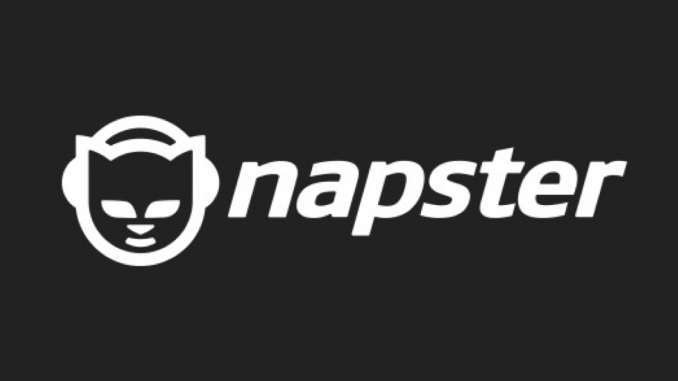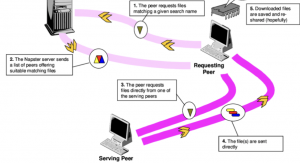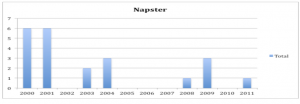
Establishment of Napster
Napster was founded in 1999, setting the stage for a peer-to-peer (P2P) platform for file sharing, with an emphasis on digital and audio content, especially audio in the form of MP3 (Andersen, 2019). After being launched, the recording industry started to view it maliciously, raising eyebrows among artists such as Dr, Dre, and Metallica, leading to legal suits, especially because of copyright infringement (Scharf, 2011). Napster Inc. was, however, determined to streamline the operations of Napster, allowing users to search for MP3 music and download through electronic gadgets provided that one had logged on to the Napster system (Andersen, 2019). The two co-founders Shawn Fanning and Sean Parker wanted the world to experience the impact of the internet on the independence of peer-to-peer sharing of files, but unfortunately, the noble idea was shortlived, having been in operations between 1999 and 2001, and opening endless possibilities to other businesses that picked from the practical concepts of sharing economy (Yen, 2000). It is worth noting that the start of the P2P concept was never a mistake, as most current developments such as Spotify were inspired by and resonate with the short-lived success story of Napster.

Napster’s Primary Fields of Operations and the Degree of Success
Shawn Fanning, Napster’s creator, made the app with the ability to share content over the internet, store electronic forms of media on computers. Besides, it was easier for users to share between users, leading to motion on violations of digital rights, ultimately leading to countermeasures to prevent computer piracy. Napster decentralized the peer-to-peer sharing of music over the internet, leading to millions of users embracing technological innovation. To make the platform user-friendly, Napster simplified how users could share and store music in MP3 format. The files could be retrieved from computers and be played just like a normal Compact Disk (CD). Once users downloaded the program, 80 million users were able to share their music, thus making Napster one of the largest music libraries of its time (Yen, 2000).
The figure below is an illustration of Napster’s peer-to-peer system.

John (2018) expounded on the concept of peer-to-peer innovations and evaluated it from a digital perspective. He argues that Napster also uses the central idea of having a unique network configuration that allows users to connect directly or indirectly through other members without the need for a central hub. Thus, P2P operation allows agents to interact freely without having to request permission. John (2018) acknowledged that Napster brought P2P to reality, although this development should be understood as more of an evolution than a revolution because the internet fundamentally operated as a peer-to-peer system. The invention affected the entire media industry because competitors learned the benefits of using digital online platforms by non-commercial organizations in order to access resources. Napster set the stage for sharing economy, leading to the adoption of similar principles and concepts by other companies such as Spotify, Netflix, Airbnb, and Uber (Van Dijck, Poell, and De Waal,2018)). These companies have gradually promoted platform capitalism where software and hardware are used to facilitate business among actors (Gillespie, 2018).
According to Van Dijck, Poell, and De Waal (2018), the sharing economy concept enhanced the Airbnb experience that was appealing all over the world for being an effective online hospitality service facilitating leasing and renting properties. The impacts were therefore not only in one industry but were widespread, leading to new ways that people travel, transport goods, watch movies, among other developments. The sharing concept has made these like-minded companies be facilitators rather than owning the product offered to the customers. For example, Spotify was managed to draw huge followership but does not own the songs that millions of people listen to every day.
How Napster Makes Money from the Activities
Initial Approach
For the survival of any business platform, making money from activities is paramount, else, the business will be forced to exit the market. Andersen (2016) argued that Napster made significant achievements through the P2P sharing service that set the stage for sharing economy and further informed the contemporary world on how to do profitable business through the engagement of a large portion of like-minded people from a given population. Napster, which would overtake incumbents such as Sony, Warner, and Universal, was under increasing pressure to sue as they began to doubt it due to its inability to cope with new developments and its low level of readiness. Despite the challenges, Napster was aware of the opportunities and the possibilities for expansion in the new market, charging a small fee of $5 per month for the many online users (Andersen, 2016).
The flexibility brought about by Napster was a source of a decline in US album sales by 8% per annum, meaning that targeted customers no longer preferred the purchase of hard copies (Andersen, 2016). As Napster continued to charge users a small subscription fee, users became more loyal and made the brand popular for being bold enough to challenge some of the existing traditions in the production of digital content that strictly regulated the sharing of online music content. However, before the emergence of other technological developments, Napster did not stay long until it was forced to buy digital music on platforms such as iTunes.
Current Strategies
Through the Napster application available in Playstore and Applestore, Napster has managed to maintain its presence through offering music that is on-demand, provision of offline playback, facilitate the creation of playlists among other functionalities that came with the 30 days trial version. The move is in line with the suggestions from Mansell and Steinmueller (2020), who argued that digital platforms are now offering a multiplicity of services such as advertising on sites, something that makes Napster make money as opposed to the initial approach. Napster is also special in the new approach because it has evolved from the free software in 1999-2000 and is now relying on paid servers for survival because of the issues associated with copyright. To remain relevant, Mansell and Steinmueller (2020), argue that businesses have to consider public interests as well as other aspects of political economy such as those that led to the collapse of Napster. From an institutional economic analysis, Mansell and Steinmueller ( 2020. p.46) argued that platform operators should not monetize activities between users, hence, a possible reason why Napster had to seek new ways to survive after the collapse.

Napster’s shift from the traditional modes of making a profit through the shift to internet services that are still highly profitable has led to significant changes in the retail market. To maintain relevance Napster is reported to have merged with Rhapsody, which was a competing firm with over 13 million songs (Perez, 2011). More specifically, remaining profitable in the media industry will require shifting to streaming services that have managed to overcome the hurdles from the traditionally based competitors claiming that unchecked technological developments are leading to infringement of copyrights.
Copyright Infringement Concerns Raised about the Napster
Unable to deal with the competition emanating from P2P developments promoted by Napster, competitors moved to court to challenge these new developments. Napster had to bow to pressure, and in 2001, a successful court injunction was given to RIAA, and ultimately, downloading, storing, and sharing songs through networked computer platforms was declared illegal (Scharf, 2011). Instead of appreciating the developments made by Napster for the purpose of making music reach out to a bigger population, Dr, Dre, Metallica, among others, held contrary views, and eventually, Napster had to close down in 2001, after promising to pay a fine of $26 million for violations of copyright to music owners.
The impact of the closing down was immediate as shown in the figure below.

In this YouTube below, a great explanation of how Napster is facing copyright issues is given and answered.
Source: The Music Industry Strikes Back | System Shock Ep 2
Suzor ( 2019, p.61), reports that millions of music files that have ever been recorded regardless of the degree of obscurity were suddenly available, leading to a form of intoxication. Suzor further noted that copyright owners started to embrace the reality that their businesses would face an existential threat at a time when the physical distribution of music was geographically limited. Through the Napster platform, users could also share illegitimate copies of music, raising concerns related to copyright infringement that needed to be kept in check. After the termination of operations, Napster was quickly replaced by other business platforms such as Grokster, eDonkey, and Aimster but their ability to comply with the raised copyright bar was still uncertain.
Reference list
Andersen, L. (2019, July 26). How Napster paved the way for the sharing economy. Retrieved from https://themngrmag.com/articles/2016/12/02/napster
Gillespie, T. (2018). Custodians of the internet: Platforms, content moderation, and the hidden decisions that shape social media. Yale University Press. https://yalebooks.yale.edu/book/9780300261431/custodians-internet?_ga=2.128098316.1481232532.1634224422-2096328328.1634224422
Guzman, A. L., & Jones, S. (2014). Napster and the press: Framing music technology. First Monday. https://firstmonday.org/article/view/5545/4124
John, Nicholas A. (2018) . Sharing Economies. In The Age of Sharing. Cambridge: Polity. pp. 69-97. DOI: https://doi.org/10.1017/S0047404518000519
Mansell, R., & Steinmueller, W. E. (2020). Advanced introduction to platform economics. Edward Elgar Publishing.
https://www.researchgate.net/publication/343793621_ADVANCED_INTRODUC
Perez, S. (2011, October 3). Rhapsody to acquire streaming music competitor Napster TechCrunch. Retrieved from https://techcrunch.com/2011/10/03/rhapsody-to-acquirestreaming-music-competitor-napster/
Scharf, N. (2011). Napster’s long shadow: copyright and peer-to-peer technology. Journal of Intellectual Property Law & Practice, 6(11), 806-812. https://doi.org/10.1093/jiplp/jpr137
Suzor, N. P. (2019). How Copyright Shaped the Internet. In Lawless (pp. 59–78). https://doi.org/10.1017/9781108666428
Twigg, A. (2020, June 17). Napster-an example of a centralized peer-to-peer system. Retrieved from https://www.researchgate.net/figure/Napster-an-example-of-a-centralized-peer-to-peer-system_fig1_2898134
Van Dijck, J., Poell, T. & de Waal, M. (2018). The Platform Society. Oxford: Oxford University Press, pp. 5-32 (‘The Platform Society as a Contested Concept’). DOI:10.1093/oso/9780190889760.001.0001
Yen, A. C. (2000). A preliminary economic analysis of Napster: internet technology, copyright liability, and the possibility of Coasean bargaining. U. Dayton L. Rev., 26, 247. http://dx.doi.org/10.2139/ssrn.259550